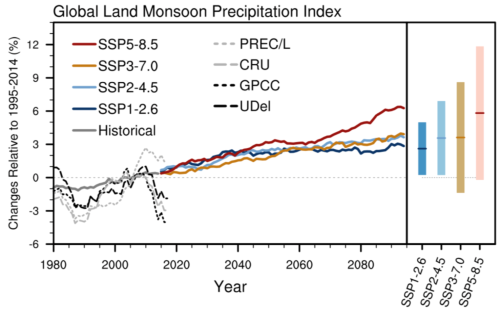Spread of Monsoon Circulation Changes Explains the Uncertainty in CMIP6 Global Land Monsoon Precipitation Projection
Date:2020-08-11
A recent work published in Geophysical Research Letters by a team of researchers from the Institute of Atmospheric Physics (IAP) at the Chinese Academy of Sciences finds that the projected uncertainty of the precipitation increase over global land monsoon regions by the Coupled Model Intercomparison Project Phase 6 (CMIP6) models is mainly due to the spread of the circulation changes across models.
Billions of people living in the global land monsoon regions rely on the freshwater resources from monsoon rainfall. Monsoon rainfall has one of the largest variabilities in the climate system, which could cause drought and flood disasters. Unusual monsoon activities would influence the livelihood of population. Both policy-makers and scientists need a reliable and accurate projection results.
In the CMIP6, four new projected scenarios (SSP1-2.6, SSP2-4.5, SSP3-7.0 and SSP5-8.5) reflect a set of alternative futures of the social and economic development. The researchers found that the global land monsoon summer precipitation increases under all scenarios, by about 2.54% and 5.75% in the lowest (SSP1-2.6) and highest (SSP5-8.5) emission scenarios. The enhancement is caused by thermodynamic responses due to increased moisture.
"Global land monsoon region is dominated by ascending motion in summer. The increase moisture due to global warming can result in the increase of vertical moisture advection and contributes to the wetting trend in summer, which is also called wet-get-wetter mechanism," said CHEN Ziming from IAP, the first author of the paper.
Meanwhile, the model spread in the projection is larger for higher emission scenarios. In addition, such spread is also larger than that in the previous CMIP projection. More importantly, the spread is related to the uncertainty of monsoon circulation changes.

Changes of global land summer monsoon precipitation in historical climate simulation and four SSPs projections of CMIP6 multimodel ensemble (MME). Changes are relative to the 1995-2014 mean. The bars represent the MME and uncertainty in the 2080-2099. Units: %. (Image by CHEN Ziming)
Circulation changes would be related to the changes of sea surface temperature (SST). But in an experiment which prescribes a uniform SST warming, the spread in the monsoon circulation changes is still evident.
"This study emphasizes the importance of reliable prediction of circulation changes, to ensure that future projections of global land monsoon are suitable for use by policy makers", added CHEN.
###
The work was supported by National Natural Science Foundation of China and the National Key Research and Development Program of China.
Reference:
Chen, Z., Zhou T.*, Zhang L., Chen X., Zhang W., & Jiang J. (2020). Global land monsoon precipitation changes in CMIP6 projections. Geophysical Research Letters, 47, e2019GL086902. https://doi.org/10.1029/2019GL086902
Media contact: Ms. LIN Zheng, jennylin@mail.iap.ac.cn
